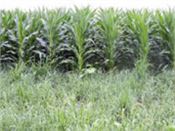Biomass Producers Can Bring In Cash While Establishing Switchgrass
URBANA, ILL.
Farmers looking to cash in on the growing biomass market may be scared off by profit losses during long establishment periods. But a new study from the University of Illinois provides a workaround.
“We have shown that farmers can grow corn as a companion crop with switchgrass to generate revenue in the establishment year,” says U of I agronomist D.K. Lee.
The idea is simple: farmers plant corn as usual, but also sow switchgrass seed in the same field approximately one week earlier. Corn shoots up quickly, leaving small switchgrass plants to establish under the corn canopy. The corn can then be harvested and sold to provide an income stream in the first year.
“The following year, switchgrass emerges early like other perennial grasses starting from crowns,” Lee says. By the end of that second year, switchgrass is typically able to produce at full capacity.
Planting corn as a companion to switchgrass is not a new idea; other studies have shown it can work. But Lee says that no clear guidelines have been established with respect to corn seeding rates or nitrogen application rates.
The experiment looked at three corn seeding rates: 28,000 seeds per acre, the standard rate at the time the study was done, and 24,000 (85 percent), and 20,000 (70 percent). It also investigated three nitrogen application rates: 0, 100, and 200 pounds per acre. After the first year, no additional nitrogen was applied. Switchgrass stand density and biomass yield was tracked over three years.
The presence of switchgrass did not negatively impact corn yield, but the addition of a corn companion crop did result in lower switchgrass density at first. Density and yield started to bounce back in the second and third years.
The study also included an economic analysis of various scenarios. “Net returns for all treatment combinations with corn were significantly more profitable than without corn, especially when fertilized with 100 or 200 pounds of nitrogen per acre during the establishment year,” Lee says.
Lee and his collaborators conclude that the use of corn as a companion crop with switchgrass can get farmers through the establishment year income gap.
The article, “Establishing switchgrass with a corn companion crop to improve economic profitability,” is published in Agronomy Journal. The study was funded by the Department of Crop Sciences at U of I and the Energy Biosciences Institute. ∆

Corn with switchgrass